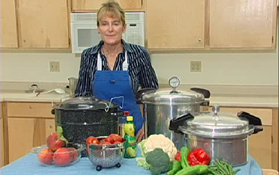Home canning of fruits and vegetables is regaining popularity thanks to the economic downturn and a growing interest in eating locally grown food. A downside to this practice is that if food is preserved improperly, consumers may become ill or die, according to University of California Cooperative Extension nutrition advisors.
If practiced properly, home canning is a safe method for preserving food. The canning process involves placing foods in jars and heating them to a temperature that destroys the microorganisms that cause food to spoil. During this heating process, air is driven out of the jar and as it cools a vacuum seal is formed. This vacuum seal prevents air and microorganisms from getting back into the jar.
If tested recipes are not followed, foodborne microorganisms can survive and they will spoil canned foods. Worse, consumers can get botulism from eating improperly home-canned foods. Botulism is a rare, but serious paralyzing illness caused by a nerve toxin produced by the bacterium Clostridium botulinum. Botulism can kill if not promptly treated.
There are two safe ways of canning food – the boiling water bath method and the pressure canner method. Boiling water is used with high-acid foods such as fruits. A pressure canner must be used with foods such as vegetables, meats and combinations containing these foods such as salsa or spaghetti sauce. Tested recipes and guidelines must always be followed to ensure safe home-canned foods.
"It is very important to follow scientifically tested canning instructions to avoid illness." said Susan Algert, UC Cooperative Extension nutrition advisor for Santa Clara County.
"The boiling water bath method is safe for fruits, jams, jellies, pickles and other acidic preserves," she said. In this method, jars of food are completely covered with boiling water (212 degrees F at sea level) and heated for a specified amount of time.
High-acid foods such as peaches naturally have a pH of 4.6 or less and contain enough acid to prevent the growth of Clostridium botulinum. High-acid foods can be safely canned using the boiling water bath method.
"Certain foods, such as tomatoes, pears and figs, have a pH value close to 4.6 and must have acid added to them to lower the pH enough to use the water bath method," Algert said. The pH can be lowered by adding commercial lemon juice or powdered citric acid.
When canning homemade salsa or other tomato products, Algert recommends following a scientifically tested recipe and using commercially bottled lemon juice to increase the acidity.
"You can’t use juice squeezed from a fresh lemon because we don’t know exactly how acidic the juice is," Algert said. "Commercial lemon juice meets a standard acidity."
To can low-acid vegetables such as green beans without a pressure cooker, the vegetables must first be pickled using a recommended recipe to ensure the final acidity is too high for Clostridium botulinum to grow.
Clostridium botulinum can form spores, a heat tolerant form of the bacteria that can survive boiling. If spores survive because of inadequate processing, they can revive and allow the bacteria to grow and produce toxins. Clostridium botulinum thrives in low-acid foods like meats and vegetables and in the absence of air in canned foods.
"The only safe method of preserving vegetables, meats, poultry and seafood to prevent botulism is pressure canning," Algert said. "These low-acid foods require heating to at least 240 degrees F for a time specified for each product. This temperature can only be reached using a pressure canner."
To ensure safety of home canned goods, she recommends using new lids to ensure a tight seal and following scientifically tested instructions.
For more information about safely canning food, visit the University of California's Food Safety website at http://ucfoodsafety.ucdavis.edu/Consumer_Advice and the USDA National Center for Home Food Preservation website at http://www.uga.edu/nchfp.
Low-acid foods:
- meats
- seafood
- poultry
- dairy products
- all vegetables
- combination products using these foods
High-acid foods:
- most fruits
- properly pickled vegetables
Foods that require added lemon juice for boiling water bath canning:

